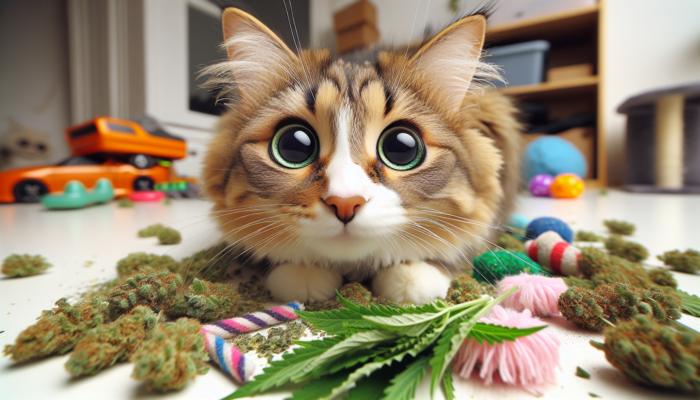Explore the Intriguing Benefits of Catnip: Comprehensive Guide and Insights
Discover the Magical World of Catnip
To fully understand catnip, scientifically known as Nepeta cataria, we need to delve into its captivating attributes. This perennial herb, part of the mint family, originates from the lush terrains of Europe and Asia, yet it has seamlessly adapted to gardens and homes around the world. With its jagged green leaves and charming white flowers, catnip may seem unassuming, but it holds extraordinary properties that can bring immense joy to our cherished feline friends.
The enchanting appeal of catnip is largely due to its essential oil, particularly the compound referred to as nepetalactone. When cats engage with catnip through sniffing, licking, or chewing, this compound interacts with their olfactory receptors, triggering a cascade of neurological responses. This interaction can lead to delightful behaviors, such as rolling, playful antics, and purring, often causing laughter from even the most serious onlookers.
What about the plant itself? Catnip thrives in sunny environments and showcases impressive resilience. Unlike many fragile plants, it flourishes in various soil types and conditions, making it a favorite among gardeners and pet enthusiasts alike. The leaves can be harvested and dried, preserving the herb’s potent qualities for a variety of cat-related products.
Understanding the Scientific Mechanisms of Catnip’s Effects on Cats
The scientific basis of catnip’s effects is as intriguing as it is complex. When cats are exposed to catnip, the nepetalactone binds to specific receptors in their nasal tissues, sending signals to the olfactory bulb in the brain. This interaction stimulates sensory neurons, revealing the euphoric behaviors we often witness. The effects are not just a fleeting high; they resemble a temporary state of feline intoxication that captivates both pets and their human companions.
Research indicates that approximately 50-75% of cats exhibit a response to catnip, with this sensitivity being primarily genetic. Kittens and elderly cats tend to show minimal to no reaction, as their receptors may be underdeveloped or diminished with age. When in contact with catnip, a cat can experience heightened excitement for about 10 to 15 minutes before typically losing interest, showcasing a fascinating cycle of stimulation followed by rest.
Interestingly, catnip is entirely harmless and poses no risk of addiction for cats. The effects are temporary, and once the initial excitement fades, felines generally return to their normal behavior. This cycle of engagement illustrates the remarkable impact of a simple herb on feline behavior, making it a captivating subject for both pet enthusiasts and researchers alike.
Exploring the Historical Importance of Catnip Across Cultures
Investigating the historical uses of catnip unveils a rich narrative woven through various cultures. Historically, catnip has not only entertained cats but has also served multiple purposes for humans. The ancient Egyptians valued this herb, utilizing it for its psychoactive effects on cats, which were seen as sacred beings. They believed that the euphoric reactions triggered by catnip were divine gifts, connecting these beloved animals to their deities.
During the medieval era in Europe, catnip was used as a herbal remedy. Brewed into tea, it was thought to alleviate ailments such as insomnia, anxiety, and digestive issues. Herbalists of the time recognized its calming properties, which continue to be appreciated in modern holistic health practices.
The journey of catnip extends even further; in various cultures, it was utilized to create mild sedatives, showcasing its versatility. Even today, it remains a popular herbal remedy, frequently found in teas and tinctures, reinforcing its status as an herb that transcends its playful reputation with cats.
Understanding the historical context of catnip enriches our appreciation for this extraordinary herb, highlighting its dual role as a source of amusement for our feline friends and a beneficial plant for human use.
Engaging with Catnip: Observing Feline Reactions and Interactions

Examining the Varied Responses of Cats to Catnip
When exploring the catnip experience, it is crucial to acknowledge that individual responses among cats can vary significantly. The behaviors triggered by catnip can differ immensely from one feline to another. For some, it sparks an exhilarating burst of energy—a frantic chase across the room as if they are hunting invisible prey. Others may respond with gentle swaying, blissful rolling, or soothing purring that can persist for several minutes, creating a scene of pure feline delight.
The effects of catnip generally manifest within seconds of exposure, prompting cats to engage in activities such as rubbing their faces against the catnip, rolling joyfully, and vocalizing with excitement. This spectacle is genuinely entertaining. Conversely, some cats may adopt a more relaxed demeanor, enjoying the aroma while lounging in a state of bliss.
Interestingly, the intensity of these reactions often depends on the freshness of the catnip. Dried catnip tends to lose potency over time, whereas fresher leaves are more likely to elicit a vigorous response. Additionally, many cats experience a ‘high’ that can vary dramatically in duration and intensity, often returning for more once they’ve had a moment to rest.
For cat owners, understanding how their pets respond to catnip is essential for creating a stimulating environment. Whether through toys infused with catnip or sprinkled on scratching posts, the key lies in observing your cat’s preferences and tailoring the experience to enhance their enjoyment.
Understanding the Timing and Frequency of Catnip Use
When navigating the world of catnip use, moderation is crucial. The duration of effects typically lasts between 10 to 15 minutes, after which many cats will lose interest and often need a break before they can fully enjoy it again. This characteristic makes catnip an excellent tool for playtime without overwhelming your furry friend.
In terms of frequency, it’s advisable to wait a couple of hours between sessions. Overexposure can dull a cat’s response, much like any pleasurable experience. However, some cats may thrive on more frequent doses, so it’s important to monitor your cat’s unique behaviors and adjust accordingly.
Introducing catnip into your cat’s routine should be approached thoughtfully. Incorporating it into playtime can serve as a stimulant that encourages exercise and mental engagement. Whether you sprinkle it on their favorite toy or provide a new catnip-infused scratching post, the key is to keep the experience fresh and engaging.
By maintaining a balanced approach to catnip use, you can ensure that your cat remains fascinated by this enchanting herb, using it as a source of stimulation and joy rather than allowing it to become a mundane part of their routine.
Understanding That Not All Cats React to Catnip

One of the most fascinating aspects of catnip is its varied effects on different cats. This phenomenon is largely attributed to genetics. Research indicates that sensitivity to catnip is hereditary, with approximately 50-75% of cats exhibiting some level of reaction. Kittens under six months and older cats may display little to no interest, as their receptors might not yet be developed or could have diminished with age.
For feline companions who remain indifferent to catnip, there’s no need for concern! Numerous alternatives exist to stimulate your cat’s interest and playfulness. Options such as <a href="https://unitypets.com/catnip-reaction-unraveling-the-feline-frenzy/">silvervine</a>, valerian root, or even honeysuckle can provoke similar reactions, opening new avenues for fun and engagement.
Moreover, some cats may simply lack the receptors that respond to nepetalactone, rendering them unaffected by the effects of catnip. Understanding this can help cat owners appreciate the individuality of their pets, ensuring that playtime remains enjoyable regardless of their response to this beloved herb.
Incorporating alternative stimulants into your cat’s life can enrich their environment, ensuring that every cat, irrespective of their reaction to catnip, finds joy and excitement in play.
Incorporating Catnip into Everyday Life: Practical Tips and Uses
Utilizing Catnip as a Powerful Training Aid
Leveraging the delightful properties of catnip for training purposes can significantly improve your relationship with your feline companion. This herb can function as a positive reinforcement tool, encouraging desired behaviors while making the training process enjoyable for both you and your cat.
When introducing catnip into training sessions, it’s essential to use it strategically. For example, if your goal is to encourage your cat to use a scratching post instead of your furniture, sprinkling some catnip on the post can entice them, making it a more appealing option. This technique can effectively redirect behaviors, fostering healthy habits while protecting your furniture.
The key is to consistently associate catnip with commands or actions. For instance, if you’re teaching your cat to come when called, rewarding them with a bit of catnip after they respond can strengthen the connection between the command and the pleasurable experience of catnip, enhancing their learning process.
Additionally, incorporating catnip during playtime can facilitate positive associations. Engaging your cat with catnip-infused toys not only stimulates their mind but also strengthens your bond, creating a fun and interactive learning environment.
Exploring the Exciting Range of Catnip Toys and Products
The market for catnip toys and products is brimming with creativity, offering a wide array of choices to delight your feline friend. From plush toys to scratching posts infused with catnip, there’s an abundance of options available to cater to every cat’s preferences.
Investing in high-quality catnip products can elevate your cat’s playtime experience. Seek out toys filled with organic catnip, ensuring they are free from harmful chemicals and additives. Reputable brands prioritize quality, often using fresh catnip, which can significantly enhance your cat’s engagement level.
Interactive toys, such as feather wands infused with catnip or puzzle feeders that dispense catnip, provide both mental stimulation and physical exercise. These products not only entertain your cat but also promote a healthy lifestyle, reducing the likelihood of boredom-related behaviors.
Moreover, don’t underestimate the joy of DIY catnip toys. Simply filling a sock with catnip and sewing it shut can create a delightful, homemade toy that your cat will adore. The joy of play is amplified when catnip is involved, making it an essential addition to any cat parent’s toolkit.
Creating Your Own Catnip Garden: A Feline-Friendly Oasis
Establishing a catnip garden can be a rewarding endeavor for cat lovers and their furry companions alike. Not only does it supply fresh catnip for your cats, but it also enhances the visual beauty of your outdoor space.
Growing catnip is relatively simple, as it thrives in a variety of conditions. It prefers well-drained soil and plenty of sunlight, making it essential to select a sunny location in your garden. Once planted, catnip requires minimal maintenance, making it an ideal choice for busy gardeners.
The benefits of cultivating your own catnip extend beyond mere aesthetics. Fresh catnip can be harvested and dried for use in toys, treats, or simply as an enjoyable sniffing experience for your cat. This not only saves money but also ensures that your cats indulge in high-quality, organic catnip that is free from pesticides and chemicals.
Additionally, a catnip garden can function as a sensory paradise for your cat. Allowing them to explore their natural surroundings can stimulate their senses and provide enriching outdoor experiences. Just be sure to supervise your cat while they’re outside, ensuring their safety in the garden.
Health and Safety Considerations: Crucial Guidelines for Catnip Use
Ensuring the Safety of Catnip for Your Feline Friend
When considering the safety of catnip, it’s important to ascertain whether this herb is suitable for our feline companions. The straightforward answer is yes—catnip is generally safe for cats. It is non-toxic and can be enjoyed in moderation without adverse effects.
However, as with any substance, moderation is key. Excessive amounts of catnip can lead to mild gastrointestinal upset in some cats, resulting in symptoms such as vomiting or diarrhea. It’s vital to monitor your cat’s reactions and adjust the frequency of exposure accordingly.
For kittens and young cats, it is advisable to wait until they are at least six months old before introducing catnip. Their sensory systems are still developing, and early exposure may not yield noticeable effects.
In summary, catnip can be a delightful addition to your cat’s life, providing stimulation and enjoyment. When monitored carefully, catnip can be a safe and enjoyable part of your pet’s daily routine.
Identifying Signs of Potential Catnip Overconsumption
Recognizing the signs of potential catnip overdose is essential for any cat owner. While it’s rare for cats to overindulge to a dangerous extent, identifying the symptoms can help ensure your pet’s wellbeing.
Signs of overexposure may include excessive drooling, vomiting, or lethargy. If your cat exhibits any of these signs following a session with catnip, it’s wise to remove the catnip and monitor them closely. In most cases, the effects will diminish after some time, and your cat will revert to their usual behavior.
If symptoms persist or worsen, consulting your veterinarian is the best course of action. They can provide you with valuable guidance and assistance to ensure your cat remains healthy and happy.
As a preventive measure, always limit catnip sessions to a few times a day and provide breaks to avoid overstimulation. This strategy not only keeps your cat safe but also preserves the delightful effects of catnip.
Introducing Catnip to Kittens: A Careful Approach
Introducing catnip to young cats necessitates a responsible approach. Given that kittens under six months old often do not possess the necessary receptors to respond to catnip, it’s wise to postpone exposure until they are older.
Once your kitten reaches the appropriate age, you can gradually introduce catnip. Start with small amounts and observe their reactions. Some kittens may display curiosity and playfulness, while others might remain indifferent.
If your kitten shows interest, you can incorporate catnip into their toys or playtime. This can serve as an exciting method to engage them and provide mental stimulation. However, if they show no reaction, that’s perfectly acceptable—numerous other toys and activities are available to keep them entertained.
Ultimately, the key to introducing catnip to kittens is patience and observation. Every cat is unique, and their response to catnip can differ. Embrace their individuality and discover what works best for your furry friend.
Exploring the Broader Applications of Catnip
Unveiling the Benefits of Catnip for Humans
While catnip is primarily recognized for its effects on felines, it also offers potential advantages for humans. Historically, catnip has been utilized in herbal medicine for its calming properties. Brewed as a tea, it’s believed to alleviate stress, anxiety, and even insomnia, making it a gentle natural remedy for those seeking relaxation.
The calming effects of catnip can be attributed to its mild sedative properties. Some studies suggest that it may help reduce anxiety and promote restful sleep. However, it’s important to note that the potency of these effects can vary from person to person.
Incorporating catnip into your wellness routine can be as simple as brewing a soothing cup of catnip tea before bedtime. As with any herbal remedy, consulting with a healthcare professional before introducing it into your regimen—especially if you’re pregnant or taking medication—is advisable.
This lesser-known aspect of catnip adds another layer of appreciation for this versatile herb, illustrating its potential to benefit not just our feline friends but humans as well.
Utilizing Catnip as an Eco-Friendly Pest Repellent
In addition to its appeal for cats, catnip also plays a role in natural pest control. The essential oils present in catnip contain compounds that can deter various pests, including mosquitoes and cockroaches.
Using catnip as a natural pest repellent is an environmentally friendly alternative to chemical solutions. You can create a simple spray by steeping dried catnip in water and using it to mist areas prone to insects, which can be especially beneficial in gardens, where a natural deterrent can protect your plants without harming the ecosystem.
Moreover, some research indicates that catnip is more effective than DEET, the active component in many commercial insect repellents. This makes it an attractive choice for those looking to reduce their reliance on synthetic chemicals.
Incorporating catnip into your gardening practices not only benefits your cats but also fosters a healthier, more sustainable environment for your home and outdoor spaces.
Integrating Catnip into Culinary Adventures
The culinary world is beginning to acknowledge catnip, showcasing its versatility beyond its allure for our feline companions. While it may not be a common ingredient in mainstream cooking, catnip can add a unique flavor profile to various dishes.
In addition to its role in teas, catnip can be incorporated into salads, soups, and even as a seasoning for meats. Its mild minty flavor can enhance dishes, providing a refreshing twist that can surprise and delight those who try it.
Furthermore, catnip may offer health advantages for humans, including anti-inflammatory and digestive properties. This makes it not just a flavorful addition to meals but also a functional ingredient that can contribute to overall wellbeing.
As culinary creativity continues to evolve, experimenting with catnip in recipes can be a delightful way to explore new flavors while honoring its rich history. Whether used as a garnish or a central ingredient, catnip can add a delightful touch to your next cooking endeavor.
Debunking Common Myths and Misunderstandings About Catnip
Clarifying Widespread Misconceptions About Catnip
As with many popular topics, catnip is surrounded by various myths and misconceptions. One prevalent myth is that all cats are affected by catnip; however, this is not accurate. As previously noted, only about 50-75% of cats respond to catnip, and this sensitivity is genetic.
Another misconception is that catnip acts as a drug that can harm cats. In reality, catnip is a safe herb that provides enjoyment without negative effects when used in moderation. It does not lead to addiction or harmful behaviors, making it a safe option for enhancing play and engagement.
Additionally, some people believe that catnip is similar to marijuana for cats, raising concerns about its legality. Contrary to common belief, catnip is a distinct plant that lacks the psychoactive properties of cannabis.
By dispelling these myths, we can foster a better understanding of catnip and its effects, enabling cat owners to make informed decisions about how to incorporate this delightful herb into their pets’ lives.
Addressing Concerns About Catnip Dependency
The question of whether cats can become addicted to catnip is a common concern among pet parents. The reassuring news is that cats do not develop a true addiction to catnip. While some felines may seem to seek out catnip frequently, the effects are temporary and do not result in dependence.
Cats may show a preference for catnip, but this is driven more by enjoying the sensory stimulation than by craving it. Once they have experienced its effects, they usually require a break before fully enjoying it again. This natural cycle of interest and disinterest is healthy.
To ensure that catnip remains a special treat rather than a daily occurrence, it’s vital to provide it in moderation. By doing this, you can maintain your cat’s enthusiasm for catnip, keeping it a source of joy and engagement.
Investigating the Relationship Between Catnip and Aggressive Behavior
Understanding the connection between catnip and aggressive behavior can help clarify another misconception. Some cat owners may worry that catnip could provoke aggression in their pets, but this is typically not the case.
Generally, catnip induces playful and euphoric behaviors rather than aggression. However, it’s essential to recognize that individual responses can vary. Some cats may become overly excited, leading to playful roughhousing that could be mistaken for aggression.
If your cat exhibits signs of aggression during catnip play, it’s wise to monitor their interactions and provide a calm environment to allow them to settle. This way, you can ensure that catnip remains a positive experience without escalating into unwanted behaviors.
Looking Forward: Future Trends and Innovations in Catnip
Exploring New Varieties of Catnip for Enhanced Enjoyment
The future of catnip is blooming with innovations and new varieties on the horizon. Breeders and horticulturists are investigating different strains of catnip, aiming to enhance their potency and appeal for our feline companions.
These new catnip varieties may present diverse scents, strengths, and even unique visual characteristics, providing cat owners with more choices. Some may be cultivated for increased resilience, making them easier to grow and care for in home gardens.
As interest in natural products continues to grow, these innovations are likely to spark a new wave of excitement among cat lovers, ensuring that catnip remains a staple in the pet industry for many years to come.
Uncovering Innovative Uses of Catnip in Veterinary Medicine
The potential applications of catnip in veterinary medicine present an exciting frontier. Researchers are beginning to explore the therapeutic uses of catnip beyond its recreational appeal. The calming properties of catnip could be harnessed to help alleviate stress and anxiety in cats, particularly during veterinary visits or in high-stress environments.
Moreover, studies are being conducted to investigate the potential benefits of catnip in managing pain or discomfort in cats. This could lead to new, natural alternatives for pain relief that align with the growing trend toward holistic and natural pet care.
As our understanding of catnip continues to expand, it may play a more prominent role in veterinary practices, promoting health and wellbeing for our beloved feline companions.
Advocating for Sustainable Catnip Farming Practices
As awareness of environmental issues increases, sustainable catnip farming practices are becoming increasingly crucial. Farmers and producers are exploring eco-friendly methods for cultivating and harvesting catnip, minimizing chemical use and prioritizing biodiversity.
Implementing organic farming techniques not only ensures a healthier product for cats but also supports sustainable agricultural practices that benefit the environment. As consumers become more conscious of their purchasing choices, the demand for sustainably sourced catnip is likely to rise.
Embracing sustainable farming practices could transform the catnip industry, aligning it with broader environmental goals while ensuring that our cats enjoy the highest quality catnip possible.
Engaging Your Cat with Catnip: Essential Enrichment Tips
Designing Interactive Catnip Play Experiences for Maximum Engagement
Creating interactive catnip play experiences can significantly boost your cat’s engagement and enjoyment. Incorporating catnip into playtime not only stimulates your cat’s mind but also encourages physical activity, which is vital for their overall health.
Consider utilizing interactive toys that dispense catnip or incorporating catnip into puzzles that challenge your cat to think and problem-solve. These activities can keep your cat entertained while providing a fulfilling challenge that combats boredom.
Participating in playtime with your cat can also strengthen your bond. Use catnip-infused toys to encourage cooperative play, allowing your cat to feel more connected to you while enjoying the delightful effects of catnip.
Enhancing Relationships Through the Magic of Catnip
The connection between catnip and bonding is profound. Catnip can serve as a tool to enhance the relationship between you and your feline friend. By creating positive experiences surrounding catnip, you can cultivate trust and affection in your relationship.
Engaging in play sessions with catnip can establish a sense of security for your cat, making them feel more comfortable and trusting in your presence. This bond can be further solidified by incorporating catnip into grooming sessions or serene cuddle times, where the calming effects of catnip foster a tranquil atmosphere.
By utilizing catnip as a bonding tool, you can deepen your connection with your pet, transforming playtime into a cherished part of your daily routine.
Using Catnip with Senior Cats: Important Considerations and Tips
When it comes to introducing catnip to senior cats, special considerations must be made. As cats age, their reactions to catnip may change, and they might not respond with the same enthusiasm as they once did.
However, this does not imply that senior cats cannot still enjoy the benefits of catnip. It can still act as a gentle stimulant that encourages playful behaviors and mental engagement. Introducing catnip in moderation can provide a refreshing source of interest and joy for older cats, significantly enhancing their quality of life.
It’s vital to closely observe your senior cat’s reactions. Some may enjoy the effects of catnip, while others may prefer different forms of stimulation. By tailoring your approach to your senior cat’s needs, you can ensure they continue to thrive in their golden years.
Frequently Asked Questions About Catnip: Detailed Answers
Can All Cats Enjoy Catnip?
Not all cats respond to catnip, as sensitivity is hereditary. Approximately 50-75% of cats display a reaction, while kittens and older cats may not be affected.
What is the Best Way to Store Catnip?
To maintain the potency of catnip, store it in an airtight container in a cool, dark place. Avoid exposure to moisture and sunlight to extend its freshness.
Where Can I Find Quality Catnip Products?
Seek organic, high-quality catnip from reputable pet stores or online retailers. Ensure it is fresh and free from additives or chemicals for the best experience.
Is Catnip Safe for Kittens?
It’s best to wait until kittens are at least six months old before introducing catnip. Their sensory systems are still developing, and they may not respond to it.
Can Catnip Help Reduce Stress in Cats?
Yes, catnip can have calming effects on cats, making it beneficial during stressful situations, such as vet visits. However, responses may vary from cat to cat.
How Often Should I Offer Catnip to My Cat?
It’s advisable to provide catnip in moderation, allowing breaks of a few hours between sessions. This prevents overstimulation and keeps their interest alive.
Do All Breeds of Cats React to Catnip?
Most cat breeds can exhibit a reaction to catnip, but sensitivity varies. Certain breeds may show little to no response based on genetic factors.
Can Humans Also Benefit from Catnip?
Yes, catnip can be beneficial for humans as well. It is often brewed as a tea to alleviate stress and promote relaxation due to its mild sedative properties.
Is Catnip Addictive for Cats?
No, cats do not develop an addiction to catnip. Their responses are temporary, and they will need breaks between sessions to fully enjoy the effects again.
Can Catnip Assist in Managing Aggressive Behavior?
While catnip typically induces playful behavior, some cats may exhibit heightened activity. It’s important to monitor interactions and provide a calm environment if aggression occurs.
Connect with us on Facebook for exclusive updates!
The Article : Catnip Explained: Your Complete Guide to Feline Fun Appeared First On Unity Pets.
The Article Catnip: The Ultimate Guide to Feline Fun and Benefits Was Found On https://limitsofstrategy.com






I’ve always been fascinated by how something so simple can bring so much joy to our cats! It’s incredible to think that just a tiny whiff of catnip can trigger such playful and vibrant behaviors. I remember the first time I introduced catnip to my cat, Oliver—he went into a delightful frenzy, rolling around as if he’d just discovered a whole new world.
It’s interesting how a simple herb can stir such a range of reactions in our feline friends. Your story about Oliver paints a vivid picture of that initial moment of curiosity turning into sheer joy. What strikes me is how each cat responds uniquely; some might go wild like Oliver, while others barely react at all. It raises a bunch of questions about what catnip really is for these animals.